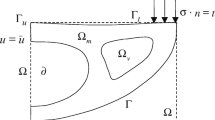Abstract
Determination of collapse load-carrying capacity of elasto-plastic material is very important in designing structure. The problem is commonly solved by elasto-plastic finite element method (FEM). In order to deal with material nonlinear problem involving strain softening problem effectively, a new numerical method-damped Newton method was proposed. The iterative schemes are discussed in detail for pure equilibrium models. In the equilibrium model, the plasticity criterion and the compatibility of the strains are verified, and the strain increment and plastic factor are treated as independent unknowns. To avoid the stiffness matrix being singularity or condition of matrix being ill, a damping factor α was introduced to adjust the value of plastic consistent parameter automatically during the iterations. According to the algorithm, the nonlinear finite element program was complied and its numerical example was calculated. The numerical results indicate that this method converges very fast for both small load steps and large load steps. Compared with those results obtained by analysis and experiment, the predicted ultimate bearing capacity from the proposed method is identical.
Similar content being viewed by others
References
LIU Tao, DENG Zi-chen. Design optimization for truss structures under elasto-plastic loading condition [J]. Acta Mechanica Solida Sinica, 2006, 19(3): 264–274.
WANG Su-yan, WANG Ze-yuan. Mechanism of improving ductility of high strength concrete T-section beam confined by CFRP sheet subjected to flexural loading [J]. Journal of Central South University, 2013, 20(1): 246–255.
LIEW J Y, CHEN H, SHANMUGAM N E, CHEN W F. Improved nonlinear plastic hinge analysis of space frame structures [J]. Engineering Structures, 2000, 22(10): 1324–1338.
LI De-jian, DAI Gong-lian, ZENG Qing-yuan. Plastic-coefficient method for space elasto-plastic ultimate load analysis of CFST arch bridge [J]. Journal of Central South University of Technology (Natural Science Edition), 2003, 34(3): 320–323. (in Chinese)
ZHAO Ming-hua, YANG Ming-hui, ZOU Xin-jun. Vertical bearing capacity of pile based on load transfer model [J]. Journal of Central South University of Technology, 2005, 12(4): 488–493.
WAN Shui NIELSEN M P. Determination of collapse load-carrying capacity of structures made of elasto-plastic material by means of FEM [J]. Journal of Ship Mechanics, 2004, 8(6): 79–84.
ZHU Jun-Gao, PENG Ka, SHAO J F, LIU Han-long. Improved slope safety analysis by new Druker-Prager type criterion [J]. Journal of Central South University, 2012, 19(4): 1132–1137.
WEN Ying, ZENG Qing-yuan. A novel approach to elasto-plastic finite element analysis of beam structures using the concept of incremental secant stiffness [J]. Finite Elements in Analysis and Design, 2010, 46(11): 982–991.
SLOAN S W, SHENG Dai-chao, ABBO A J. Accelerated initial stiffness schemes for elastoplasticity [J]. International Journal for Numerical and Analytical Methods in Geomechanics, 2000, 24(6): 579–599.
ZIEMIAN R D, MCGUIRE W. Modified tangent modulus approach, a contribution to plastic hinge analysis [J]. Journal of Structural Engineering, 2002, 128(10): 1301–1307.
LADOPOULOS E G. Singular integral operators method for two-dimensional plasticity problems [J]. Computers & Structures, 1989, 33(3): 859–865.
BARHAM W S, AREF A J, DARGUSH G F. Flexibility-based large increment method for analysis of elastic-perfectly plastic beam structures [J]. Computers and Structures, 2005, 83(28/29/30): 2453–2462.
KLAUS J B, ARTHUR P C. Some practical procedures for the solution of nonlinear finite element equations [J]. Computer Methods in Applied Mechanics and Engineering, 1980, 22(1): 59–85.
ZHAO Qi-lin, NIU Hai-qing, ZHUO Jia-shou. Basic problems of strain-softening material [J]. Hydro-Science and Engineering, 2001, 3: 73–77. (in Chinese)
MILAN J, SIMON R. Comparison of integral-type nonlocal plasticity models for strain-softening materials [J]. International Journal of Engineering Science, 2003, 41(13/14): 1553–1602.
YIN You-quan. Nonlinear finite element foundation [M]. Beijing: Peking University Press, 2007: 45–48. (in Chinese)
OWEN D R J, HINTON E. Finite element in plasticy: Theory and practice [M]. Swansea: Pineridge Press, 1980: 215–234.
HODGE P G, WHITE G N. A quantitative comparison of flow and deformation theories of plasticity [J]. Journal of Applied Mechanics, 1950, 17(2): 180–184.
THEOCARIS P S, MARKETOS E. Elastic-plastic analysis of perforated thin strips of a strain-hardening material [J]. Journal of the Mechanics and Physics of Solids, 1964, 12(6): 377–390.
Author information
Authors and Affiliations
Corresponding author
Additional information
Foundation item: Project(2012CB026200) supported by the National Basic Research Program of China; Projects(50978055, 50878048) supported by the National Natural Science Foundation of China
Rights and permissions
About this article
Cite this article
Zhong, Zp., Ren, Dl. & Wan, S. A new numerical method for determining collapse load-carrying capacity of structure made of elasto-plastic material. J. Cent. South Univ. 21, 398–404 (2014). https://doi.org/10.1007/s11771-014-1953-0
Received:
Accepted:
Published:
Issue Date:
DOI: https://doi.org/10.1007/s11771-014-1953-0




